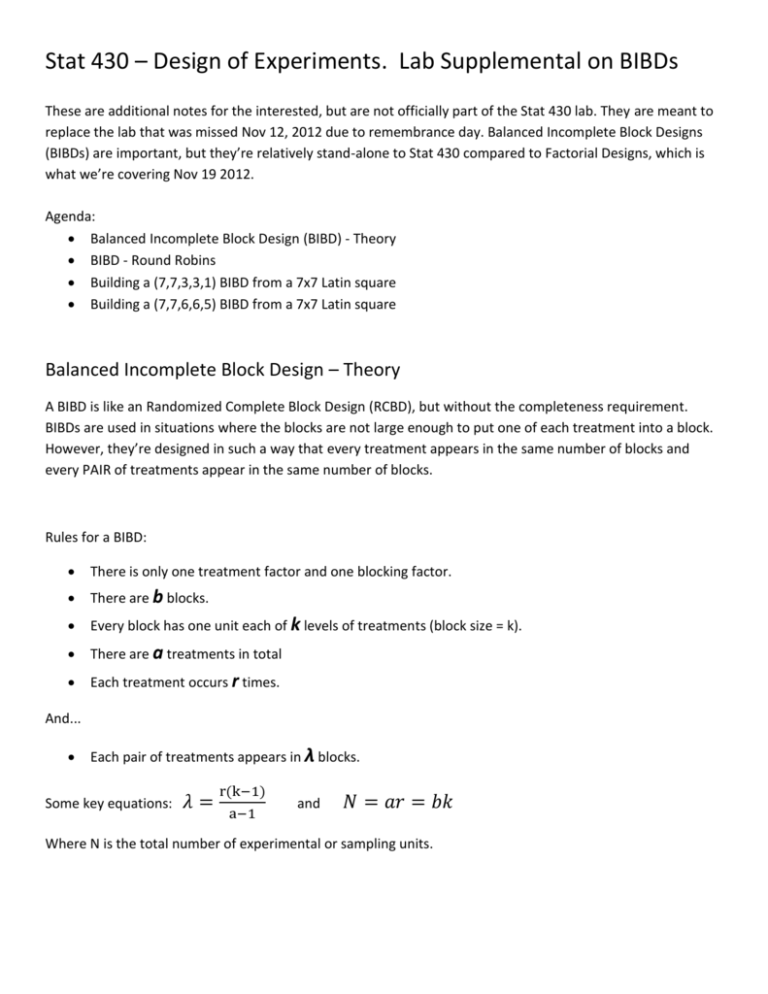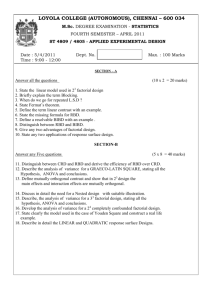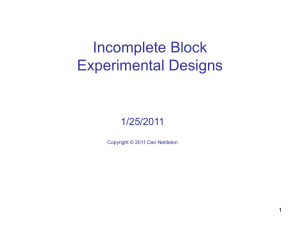Extra_BIBD
advertisement

Stat 430 – Design of Experiments. Lab Supplemental on BIBDs
These are additional notes for the interested, but are not officially part of the Stat 430 lab. They are meant to
replace the lab that was missed Nov 12, 2012 due to remembrance day. Balanced Incomplete Block Designs
(BIBDs) are important, but they’re relatively stand-alone to Stat 430 compared to Factorial Designs, which is
what we’re covering Nov 19 2012.
Agenda:
Balanced Incomplete Block Design (BIBD) - Theory
BIBD - Round Robins
Building a (7,7,3,3,1) BIBD from a 7x7 Latin square
Building a (7,7,6,6,5) BIBD from a 7x7 Latin square
Balanced Incomplete Block Design – Theory
A BIBD is like an Randomized Complete Block Design (RCBD), but without the completeness requirement.
BIBDs are used in situations where the blocks are not large enough to put one of each treatment into a block.
However, they’re designed in such a way that every treatment appears in the same number of blocks and
every PAIR of treatments appear in the same number of blocks.
Rules for a BIBD:
There is only one treatment factor and one blocking factor.
There are b blocks.
Every block has one unit each of k levels of treatments (block size = k).
There are a treatments in total
Each treatment occurs r times.
And...
Each pair of treatments appears in λ blocks.
Some key equations:
𝜆=
r(k−1)
a−1
and
𝑁 = 𝑎𝑟 = 𝑏𝑘
Where N is the total number of experimental or sampling units.
BIBDs have some design challenges similar to those of Latin Squares. You can’t just make blocks haphazardly.
For example, it’s impossible to make a BIBD for an experiment with a = 6 treatment levels each which appears
in r = 4 blocks because...
N = ar = 24, so bk = 24.
You need at least b=4 blocks because each treatment appears in r=4 blocks, and N is an integer, so b = 6, 12, or
24, and k = 4, 2, or 1 respectively. None of the possible k values produce a λ which is an integer, so no BIBD
can be constructed from these parameters. There are other restrictions besides making sure all the values of
a,b,k,r, and λ are whole numbers, but they’re usually covered in a course in applied abstract algebra.
A BIBD with a=b=7 and k=r=3 and λ =1 can be constructed by taking three rows of a standard 7x7 Latin Square
as long as those rows aren’t consecutive. (example: The 1st,2nd, and 4th rows work; the 1st,2nd,and 3rd don’t)
Aside from their construction, there is another complication: The means of treatments aren’t directly
comparable because they don’t appear in the same set of blocks. To analyze the results of a BIBD we need
adjusted treatment means and an adjusted SStreatment . Qi is the adjusted treatment total and
SStreatment(adj.)
=
2
∑𝑎
𝑄
𝑖=1 𝑖
𝜆𝑎
𝑏
1
𝑄𝑖 = 𝑦𝑖. − ∑ 𝑛𝑖𝑗 𝑦.𝑗
𝑘
𝑗=1
Where nij is the number of treatments i are in block j. There is also an adjustment for block totals, but for
ANOVA you only need to adjust for treatment totals OR block totals, but NOT both. All formulae on Page 169171.
Balanced Incomplete Block Design Example – Round Robin Hockey
Consider the results from a pool of teams at the 2010 World Juniors Hockey Tournament**.
Team
Game 1 Game 2 Game 3 Game 4
Sweden
7
Canada
6
7
Russia
3
C.R.*
2
2
Norway
1
0
*Stands for Czech Republic
** 2010 IIHF World U20 Juniors, to be exact.
Game 5
2
Game 6
Game 7
6
Game 8
10
0
8
3
1
2
Game 9
6
5
Game 10
8
3
First, some definitions:
A sample unit is a Team`s Score
A treatment is a Team
A block is a Game
Next, find the design parameters (not to be confused with the distribution parameters):
Number of treatments (teams), a = 5
Number of blocks (games), b = 10
Size of a block (teams/game), k = 2
Blocks for each treatment (games/team), r = 4
There are N = ar = bk = 20 scores recorded.
Each pair of teams is in λ = r(k-1)/(a-1) = 4(2-1)/(5-1) = 1 game together.
Null hypothesis to test: All the team’s mean scores are the same.
Solution: Do an ANOVA with adjusted treatment totals.
Put the data into R
team =
c("B_Canada","C_Russia","A_Sweden","E_Norway","D_CzechRepub","E_Norway","B_Canada
","D_CzechRepub","A_Sweden","C_Russia","B_Canada","E_Norway","A_Sweden","D_CzechR
epub","C_Russia","E_Norway","A_Sweden","B_Canada","C_Russia","D_CzechRepub")
goals = c(6,3,7,1,2,0,7,2,2,0,10,1,6,3,8,2,6,5,8,3)
game = as.factor(rep(1:10,each=2))
hockey = data.frame(game,team,goals)
Input the basics and design parameters
y = hockey$goals
trt = hockey$team
blk = hockey$game
k = 2
lambda = 1
a = 5
Get the SS.Total and SS.Blocks the usual way
SS.total = sum ( (y - mean(y))^2)
y.j = as.numeric(by(y,blk,sum))
SS.blocks = 1/k * sum(y.j^2) - sum(y)^2/length(y)
Get the adjusted means
yi. = as.numeric(by(y,trt,sum))
nij = matrix( c(0,1,0,0,1,0,1,0,1,0,1,0,0,1,0,1,0,0,1,0,1,0,0,0,1,
0,0,1,0,1,0,0,1,1,0,0,1,0,0,1,0,1,1,0,0,1,0,1,0,0), byrow=TRUE, nrow=5, ncol=10)
Qi = c(0,0,0,0,0)
for(i in 1:5)
{
Qi[i] = yi.[i] - 1/k * sum( nij[i,]*y.j)
}
Get the adjusted SS treatment and SS error
SS.trt.adj = k*sum(Qi^2)/(lambda*a)
SS.error = SS.total - SS.blocks - SS.trt.adj
Perform an ANOVA
MS.trt = SS.trt.adj / 4
## 5 teams, 4 df
df.error = 19 - 4 - 9 ## N = 20, so 19 total, - 4 for teams, - 9 for games
MS.error = SS.error / df.error
F = MS.trt / MS.error
1 - pf(F, df1=4, df2=6)
Building a (7,7,6,6,5) BIBD from a 7x7 Latin Square
Some, but far from all, BIBDs can be constructed by taking a subset of the rows (or columns) of a BIBD. For
example, if you take any six rows from a 7x7 Latin Square...
A
B
C
D
E
F
G
B
C
D
E
F
G
A
C
D
E
F
G
A
B
...then you have a BIBD.
- Each letter of ABCDEFG is a treatment (a = 7).
- Each letter appears 6 times (r = 6).
- Every column is a block (b = 7) of size 6 (k = 6).
D
E
F
G
A
B
C
E
F
G
A
B
C
D
F
G
A
B
C
D
E
G
A
B
C
D
E
F
Therefore the total number of sample units is:
𝑁 = 𝑎𝑟 = 𝑏𝑘 = 7 ∗ 6 = 42
Each pair of treatments appears in
r(k−1)
6(6−1)
𝜆=
=
=5
a−1
7−1
blocks.
So (a,b,k,r, λ) = (7,7,6,6,5).
You can verify by hand that every pair appears exactly 5 times, but I recommend you take advantage of
symmetric and only check AB, AC, AD, AE, AF, and AG. It’s intuitive that there should be 5 copies of each pair
because among the 7 blocks, one will be missing the first treatment of the pair, and one will be missing the
second treatment.
I’ll state without proof that by similar logic, a BIBD can be constructed by a removing a single row or column
from any Latin square of size 3x3 or larger. However, it doesn’t afford much savings in terms of sample units
needed.
Building a (7,7,3,3,1) BIBD from a 7x7 Latin Square
Other subsets of Latin squares can also produce BIBDs. Not every subset works though.
For example, no BIBD comes from taking 2 rows from a 4x4 Latin square because:
b = 4, a = 4, k = 2, r = 2, and...
𝜆=
r(k − 1)
2(2 − 1)
=
= 2/3
a−1
4−1
...which is NOT AN INTEGER, so no BIBD is possible (you can’t have 2/3 of a pair in a block).
However, if we take 3 rows from a 7x7 Latin square, then
b = 7, a = 7, k = 3, r = 3, and...
𝜆=
r(k − 1)
3(3 − 1)
=
=1
a−1
7−1
So it COULD be possible to build a BIBD (it usually is, but this isn’t a guarantee). If we take the first three rows
of a standard 7x7 Latin square...
A
B
C
B
C
D
C
D
E
D
E
F
E
F
G
F
G
A
G
A
B
...we run into a problem. Pairs of consecutive lettered treatments like AB and BC appear twice and other pairs
like AD and BF don’t appear at all. In other words, this design isn’t balanced.
However, if we take the 1st, 2nd, and 4th rows of a standard 7x7 Latin square, we get a different result.
A
B
C
D
B
C
D
E
C
D
E
F
D
E
F
G
E
F
G
A
F
G
A
B
G
A
B
C
AB, AD
AE, AF
AC, AG
Every pair appears exactly once.
When constructing a BIBD, the number of pairs being an integer is a good quick check, but to sure you have to
get your hands dirty and check directly. In this case, it could be worth the effort because we only need N = 21
samples to look at 7 treatments and still see every pair.










